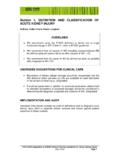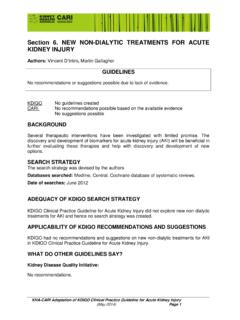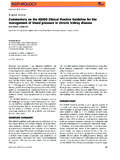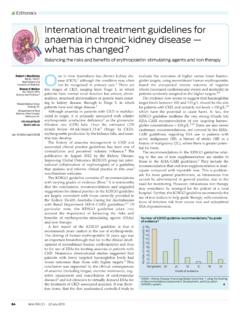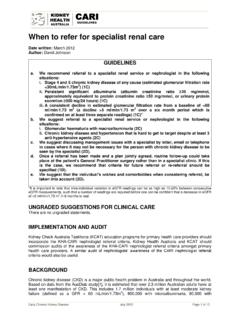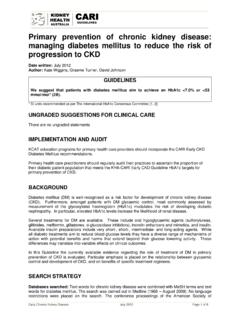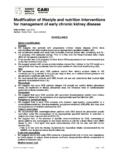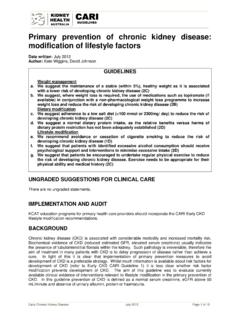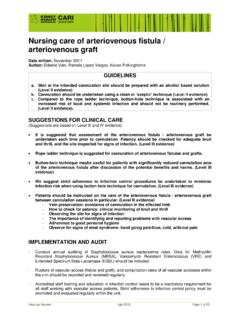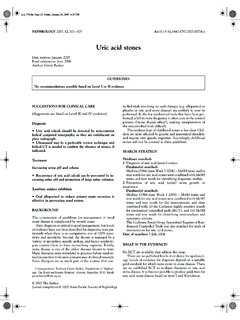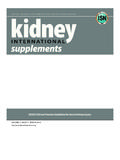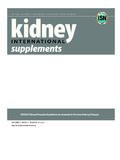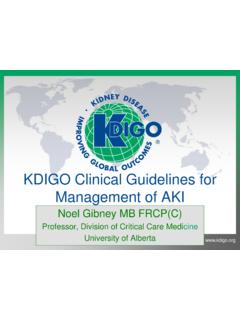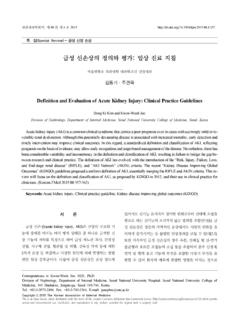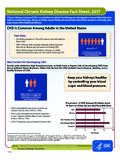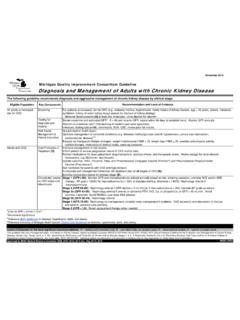Transcription of Diagnosis, classification and staging of chronic …
1 _____Early chronic kidney Disease July 2012 Page 1 of 31 Diagnosis, classification and staging of chronic kidney disease Date written: July 2012 Author: David Johnson GUIDELINES DIAGNOSIS a. We recommend that chronic kidney disease (CKD) be diagnosed in all individuals on at least 2 occasions for a period of at least 3 months, irrespective of the underlying cause and on the basis of: (1C) an estimated or measured glomerular filtration rate <60 mL/ m2 and/or evidence of kidney damage (albuminuria, proteinuria, haematuria after exclusion of urological causes, or structural abnormalities on kidney imaging tests) Note: These diagnostic criteria are the same for all races and gender classification AND staging b. We recommend that the stages of CKD should be based on the combined indices of kidney function (measured or estimated GFR) and kidney damage (albuminuria/proteinuria), irrespective of the underlying diagnosis (1C).
2 kidney function stage* GFR (mL/ m2) Description 1 90 Normal or increased GFR 2 60-89 Normal or slightly decreased GFR 3A 45-59 Mild-moderate decrease in GFR 3B 30-44 Moderate-severe decrease in GFR 4 15-29 Severe decrease in GFR 5 <15 or on dialysis End-stage kidney failure kidney damage stage* Urine albumin/ creatinine ratio (mg/mmol) 24h urine albumin (mg/day) Urine protein: creatinine ratio (mg/mmol) 24h urine protein (mg/day) Normoalbuminuria < (M) < (F) <30 <4 (M) <6 (F) <50 Microalbuminuria (M) (F) 30-300 4-40 (M) 6-60 (F) 50-500 Macroalbuminuria >25 (M) >35 (F) >300 >40 (M) >60 (F) >500 *When reporting kidney function, stage (stages 1-5) is combined with kidney damage (albuminuria/proteinuria (Norm/Micro/Macro-albuminuria)) and clinical diagnosis to fully specify CKD stage (eg Stage 2 CKD with microalbuminuria secondary to diabetic nephropathy). Note: These staging criteria are the same for all races and gender.
3 C. We recommend that these staging criteria be used to stratify CKD patient risk and be linked with specific management plans according to that level of risk (1C). _____Early chronic kidney Disease July 2012 Page 2 of 31 Albuminuria stage kidney function stage GFR (mL/ ) Normal (urine ACR mg/mmol) Male: < Female: < Microalbuminuria (urine ACR mg/mmol) Male: Female: Macroalbuminuria (urine ACR mg/mmol) Male: > 25 Female: > 35 1 90 Not CKD unless haematuria, structural or pathological abnormalities present 2 60-89 3a 45-59 3b 30-44 4 15-29 5 <15 or on dialysis Risks of progressive CKD denoted as low (green), moderate (yellow), high (orange) and very high (red). [For specific management plans refer to chronic kidney Disease Management in General Practice [1]] Note: For patients with CKD, the combination of a low GFR and albuminuria or proteinuria places them at a greater risk of CKD progression at all ages, than those with just low GFR, albuminuria or proteinuria.
4 A measured or estimated GFR <45 mL/ is associated with increased risks of adverse renal, cardiovascular and other clinical outcomes, irrespective of age. d. We recommend that when CKD is initially diagnosed, to consider the underlying cause and to pursue the diagnosis sufficiently to exclude treatable pathology, such as obstruction, vasculitis, nephrotic syndrome and rapidly progressive glomerulonephritis (1C). e. We recommend an early repeat of the eGFR test if there is any suspicion of an acute condition. It is particularly important to be sure that acute kidney disease is not missed by assuming the first abnormal eGFR represents a long-standing condition (1C). f. We recommend that the above criteria for CKD diagnosis and staging be applied irrespective of age (1C). UNGRADED SUGGESTIONS FOR CLINICAL CARE DIAGNOSIS i. The following diagnostic evaluation tests for CKD are always indicated: Full blood count Repeat (within 1 week) serum urea/electrolytes/creatinine/eGFR/albumi n Urine albumin: creatinine ratio (preferably on a first morning void, although a random urine is acceptable) Fasting lipids and glucose Urine microscopy and culture Renal ultrasound scan ii.
5 The following diagnostic evaluation tests for CKD are sometimes indicated: _____Early chronic kidney Disease July 2012 Page 3 of 31 If patient: Then carry out the following test: Has diabetes HbA1C Has eGFR < 60 mL/ Serum calcium, phosphate, PTH, 25-hydroxy-vitamin D and iron studies Is > 40 years old Serum and urine electrophoresis Has rash, arthritis or features of connective tissue disease Anti-nuclear antibodies, Extractable nuclear antigens, Complement studies Has pulmonary symptoms or deteriorating kidney function Anti-glomerular basement membrane antibody, Anti-neutrophil cytoplasmic antibody Has risk factors for HBV, HCV and HIV HBV, HCV, HIV serology Has persistent albuminuria >60-120 mg/mmol (approximately equivalent to 24hr urinary protein >1-2 g/day) Refer to Nephrologist for consideration of renal biopsy IMPLEMENTATION AND AUDIT kidney Check Australia Taskforce (KCAT) education programs for primary health care providers should incorporate the CARI chronic kidney disease (CKD) classification system.
6 KHA and KCAT should commission audits of the awareness of the CARI CKD classification amongst primary health care providers. BACKGROUND chronic kidney disease is a major public health problem in Australia and throughout the world. Based on data from the AusDiab study [2], it is estimated that over million Australian adults have at least moderately severe kidney failure, defined as an estimated glomerular filtration rate (eGFR) less than 60 mL/ m2. This pernicious condition is often not associated with significant symptoms or urinary abnormalities and is unrecognized in 80-90% of cases [2-4]. CKD progresses at a rate that requires approximately 2300 individuals each year in Australia to commence either dialysis or kidney transplantation [5]. Furthermore, the presence of CKD is one of the most potent known risk factors for cardiovascular disease, such that individuals with CKD have a 10- to 20-fold greater risk of cardiac death than age- and sex-matched controls without CKD [6-8].
7 Developing an operational definition and classification of the stages of CKD is therefore critically important for guiding research to provide estimates of CKD prevalence by stage, developing a clinical action plan for evaluating and managing each stage of CKD, and for defining individuals at increased risk of developing progressive CKD and cardiovascular disease. Historically, the definition of CKD has been vague, accompanied by variable and imprecise terminology (such as chronic renal failure, chronic renal insufficiency, pre-dialysis, and pre-end-stage renal disease ), and categorised mainly by cause [9]. In principle, CKD should be diagnosed and classified according to severity, diagnosis, treatment and prognosis, and should be readily linked to clinical action plans to facilitate management (particularly in the primary care setting).
8 Although the aetiology of CKD may have important implications for management under certain circumstances, this is not the case for the majority of CKD encountered by clinicians. Nevertheless, it remains important in all patients when CKD is initially diagnosed to consider the underlying cause and to pursue the diagnosis sufficiently to exclude treatable pathology, such as obstruction, vasculitis, nephrotic syndrome and rapidly progressive glomerulonephritis. It is particularly important to be sure that acute kidney disease is not missed by assuming the first abnormal eGFR represents a long-standing condition. In 2002, the National kidney Foundation s kidney Disease Outcomes Quality Initiative (KDOQI) [10] published a guideline on CKD covering evaluation, classification , and stratification of risk. The diagnosis of CKD definition was based on 3 components: (1) an anatomical or structural component (markers of kidney damage, including albuminuria), (2) a functional component (based on GFR), and (3) a temporal component (at least 3 months duration of structural and/or functional alterations).
9 The KDOQI Guidelines also recommended 5 CKD stages system based on the GFR cut-points of 90 mL/ m2 (the lower limit of normal for healthy young adults), 60 mL/ m2 (the threshold below which _____Early chronic kidney Disease July 2012 Page 4 of 31 eGFR has been validated to have acceptable accuracy), 30 mL/ m2 (the threshold below which there is broad consensus that referral to a nephrologist is generally indicated) and 15 mL/ m2 (the upper limit at which most patients with CKD start renal replacement therapy). Because of the limited accuracy of eGFR at normal or near-normal levels of renal function, the diagnosis of CKD at eGFR levels above 60 mL/ m2 required concomitant evidence of kidney damage. However, an eGFR < 60 mL/ m2 was considered to represent CKD, irrespective of age, gender, race or any other factors. There has since been broad consensus and supportive observational evidence that the diagnosis and staging of CKD should be based on both an evaluation of kidney function (ie.)
10 Estimated or measured glomerular filtration rate (GFR) and the presence or absence of kidney damage (persistent albuminuria, persistent proteinuria, persistent haematuria after exclusion of urological causes, or structural abnormalities on kidney imaging tests) [10-15]. However, the use of an isolated estimated GFR threshold of 60 mL/ m2, uncorrected for age and gender, to define the presence of CKD even in the absence of evidence of kidney damage has been criticised by some authors [16-18]. There has also been criticism of the focus of current CKD diagnosis and staging systems on eGFR without appropriate consideration of the important role of concomitant proteinuria/albuminuria for risk stratification [19]. Recent guidelines in the United Kingdom published by the National Institute for Health and Clinical Excellence (NICE) (10,11) have attempted to address these criticisms by dividing CKD stage 3 into stages 3A and 3B (eGFR 45 to 59 mL/ m2 and 30 to 44 mL/ m2, respectively), and the addition of the suffix p to CKD staging for significant proteinuria.
